Author Archive
Posted on: February 5th, 2014 by Waterloo Region Crime Prevention Council
In the first part of our follow up to the Snapshot on Crime series, we shared some themes and commonalities we found in the informative, thought-provoking responses of community residents and leaders to the report – A Snapshot in Time: The Root Causes of Crime in Waterloo Region. Each contributor reflected on local data in the report concerning one social, community or economic circumstance associated with increases or decreases in crime. We shared powerful quotes from contributors illustrating the importance of individual actions, and the need for transformative changes, like changes in attitudes, in order to address the root causes of crime. There was so much to share, we couldn’t fit them all in to one blog post. Read on….
Multiple Interconnected Roots Require Holistic Approaches
The connections between social, economic and community circumstances and crime are complex. There are often multiple circumstances that adversely impact people and communities requiring coordinated, holistic responses to the interconnected roots of crime and victimization.
For example, Jill Stoddart explains that children in care of child welfare “often come from disadvantaged families and have been subjected to maltreatment and neglect” and thus “are often at higher risk of involvement in the youth justice system, homelessness, substance abuse” and other problems.
While being young and male is associated with an increased risk of crime and victimization, Rohan Thompson from the inREACH gang prevention project says “the vast majority of youth crime is being committed by a small number of young offenders.” Further, these youth “have lived and been exposed to risks most of their young life, so participation in a gang is just the symptom of deeper more complex issues…” requiring “a holistic long term approach.”
Since “length of involvement in schooling significantly impacts participation in criminal activity,” school boards go to “great lengths” to decrease the number of residents without a high school education. David DeSantis gives examples of Catholic school board initiatives such as the “Supervised Alternative Learning programs [that] allow students to work full-time, get mental health supports, volunteer hours and accumulate credits.”
Challenging the way root causes are framed
Some writers questioned or re-framed the indicators defined as root causes in the report.
Julie Philips for example, questioned the association of higher crime rates with higher proportions of single parent headed households.
“…children and youth from fragmented households are perhaps just as likely to commit crime as lone-parent offspring. What do I mean by fragmented? A two parent family, where the parents… at the end of the day are too tired, burned out and stressed, leaving little time or energy to actively engage their children. “
Innovative responses
Waterloo Region’s reputation as a social and economic innovator was clearly demonstrated by our community’s innovative responses to root causes.
Sue Klassen tells how “restorative justice reduces fear of crime.”
“She [victim] learned that Brianna was not the monster that she had imagined her to be, but a troubled young woman who had been the past victim of rape and abuse, trying to turn her life around. Carol’s fear was transformed.”
Aaron Stauch says that although unemployment rates are improving, this “masks some concerning trends for specific segments of our workforce. Unemployment for youth, new Canadians…and older workers has remained high.” “..There are many local organizations implementing innovative ways of addressing these employment challenges.”
Moving Upstream
Many writers emphasized the critical need to focus more attention on preventing problems from occurring in the first place.
Amy Romagnoli explains that many community organizations “place great value on early child development as an up-stream approach to preventing negative child outcomes…Programs that promote and offer early learning opportunities need to be prioritized, implemented and given a chance to prove their value in the long term.”
So… where does all this leave us?
First, the good news, crime rates have been steadily falling in Waterloo Region and the Snap Shot in Time report shows Waterloo Region is committed to paying attention to the root cause of crime. “A continued diligent effort to monitor and intervene in the root causes of crime is a powerful tool for ensuring that this trend can continue into the future.”
The overall picture, as illustrated in the report, for Waterloo Region is mixed. Some statistics are positive, such as higher rates of social capital compared to Ontario or Canada. In some areas, such as the percentage of people without a high school education, we are doing about the same. Yet in other areas, like some early childhood indicators, we are falling behind. The picture is incomplete though as some key indicators, such as alcohol consumption and recreational substance use cannot be tracked due to lack of reliable data.
Community residents and leaders described the important work being done in our community to address the root causes of crime and victimization and to build a safe and healthy community for everyone. They shared their insights, stories, and calls for action. One of the important messages is that everyone can make a difference – so join us!
What more do we need to do? Considering all the good efforts already under way, are you satisfied with the work of the community or would you like to do more? Is there a particular area in which you would like to see our community put more collective and concentrated effort?
Essentially…. Where do we go from here? Speak up community, you’re great at this! And you’re great at making things happen too.
Where would you like to get started?
Posted on: February 4th, 2014 by Waterloo Region Crime Prevention Council
How do we get at the root causes of crime and prevent it from happening in the first place?
This isn’t a direct, straight answer, but, the Waterloo Region Crime Prevention Council believes part of the solution is to monitor the root causes of crime over time. Then we, as a community, can better understand and address the social, community and economic conditions associated with crime and victimization. Check out the Waterloo Region Crime Prevention Council’s report – A Snapshot in Time: The Root Causes of Crime in Waterloo Region to find out how we are doing in early childhood development, employment, community trust and other important indicators.
In the months following the report’s release, community residents, leaders and experts wrote blogs responses to share stories, insights and examples of how our community is responding to the root causes of crime outlined in the report. When we read all the fantastic community responses together like a book, we started to notice some themes and commonalities.
Individual actions matter
Many blogs responses focused on the importance of individual actions in building a safe and healthy community. Volunteering, owning a home and having a stake in a healthy neighbourhood or simple acts of noticing instead of “pretend(ing) to be an island” all make a positive difference .
Waterloo City Councillor, Karen Scian, tells a moving story of her encounter with a ‘squeegee kid’ at a red light as a way of illustrating how social capital (positive connections between people) is something we can all build and that protects against crime.
“His green eyes instantly reminded me of [my son] Peter. What if? …I…called him over…We chatted…and [I] gave him paper money. I gave him my business card. I asked him to call his mom…He thanked me again and told me that he was going to get something to eat and that he would call his mom…I had to hope.”
Higher levels of home ownership also serve as a protective factor against crime. Local realtor Keith Marshall is optimistic since “we are trending well in Kitchener-Waterloo. Crime is down. Homeownership is up. Neighbourhoods that were considered unsafe and decaying fifteen years ago are transforming into sought after and vibrant places to live.”
Calls for transformative changes to address root causes
Many contributors spoke passionately of the need for deep structural changes in our communities and systems in order to transform the social and economic conditions that contribute to crime and victimization.
In reflecting on the “deplorable” rates of violence against women and the need for a larger shelter in Waterloo Region in recent years, Mary Zilney asks:
“Why doesn’t our government create a system whereby the women and children remain in the family home and the abuser is removed? …Instead of building bigger shelters, we need to turn our minds to how we collaboratively eradicate violence against women.”
Part of the solution lies in changing attitudes and awareness
Many contributors agreed that part of the societal transformation required to address the root causes of crime and build healthy communities is changing attitudes so that all people are valued and treated with respect and understanding.
Sara Casselman writes about an innovative program to reduce incidences of sexual assault that works “with men in positions to influence male youth.” This program “encourages young men to treat women with fairness, equality and respect and to stand up and speak out on gendered violence.”
Sheri Cartwright, a community volunteer, reflects on the connection between homelessness and the increase in victimization and minor crimes among those who are without a home:
“when we provide those in need with stable housing we give the opportunity to live with dignity, reduce crime, reduce addiction and give the opportunity for better success. It is a win, win situation…We need to put as much effort into creating awareness and fundraising for this as we do when collecting food and socks.”
According to Mary MacKeigan who writes about the income of low income families and individuals:
“the root of all root causes…is the stigmatization of people living in poverty. Societal attitudes / values impact our political voting choices and influence policy decisions…. if enough of us TRULY believed that everyone was a valuable member of society, we’d have much better policies in place that reflect that belief.”
Thank you to the community contributors for sharing these insights and calls to action. There’s more to come. Tune in to the next blog for part two of The Community Weighs in on the Root Causes of Crime. We’ll review the some more themes and provide additional reflections and food for thought.
Posted on: January 21st, 2014 by Waterloo Region Crime Prevention Council
Public opinion polls have been asking Canadians questions about crime policy, perceptions of crime, and attitudes towards the criminal justice system for over forty years. During this time over 700 questions about crime have been asked by Gallup, Pollara, Ipsos Reid, Statistics Canada’s General Social Survey, the Canadian Election Study and Environics Institute. LISPOP associate Dr. Steve Brown and I have assembled these questions in an archive and are using them to track changes in the public’s views about criminal justice matters over the past few decades.
For more on how public opinion towards crime in Canada has changed over time, please visit lispop.ca. Here, I will focus on how shifts in public opinion towards crime can influence policy.
The relationship between public opinion and policy is complex. In 2000, Barbara Norrander published a study examining capital punishment practices in the United States. Her research shows current death penalty policy in a state is shaped by past policy, political culture and current public opinion. Current opinion is also influenced by past policy and socio economic background. But since past policy is shaped by past opinion there is an indirect effect, where past opinion helps to shape current opinion by changing past policy. Confused yet? Despite the complicated explanation and diagram, below, it’s actually fairly straightforward; past opinion and past policy are constantly influencing one another shaping both current policy and current opinion. Okay, maybe it’s not simple, but it certainly is elegant.
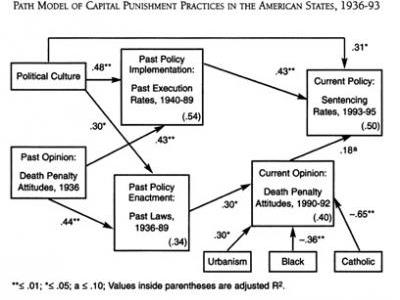
Norrander, 2000 The Multi-Layered Impact of Public Opinion on Capital Punishment Implementation in the United States
This model provides a useful explanation for attitudes towards capital punishment in Canada. Support for capital punishment has been steadily falling since the 1980s. Over 80% of respondents supported capital punishment in the early 1980s, since this time support has fallen significantly. Today when respondents are asked if they support capital punishment for certain crimes support is below 55%.
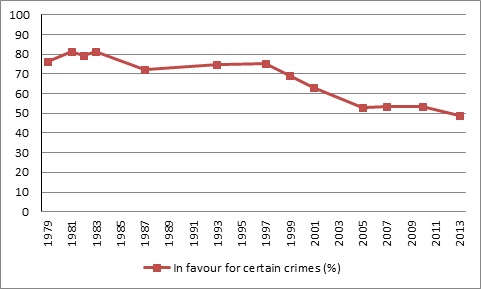
Support for Capital Punishment
This drop in support can be explained, at least partially, by the abolishment of the death penalty in Canada on July 14th, 1976 (the last execution in Canada took place on December 11th, 1962). Any Canadian, who grew up after this time, grew up in a Canada without the death penalty. So a policy decision, which at the time went against public opinion, helped to shape future public opinion by normalizing a Canada without the death penalty.
Public opinion does not always work this way. Often public opinion will react in the opposite direction of policy decisions. James Stimson a researcher in the United States wrote two books, Tides of Consent and Public Opinion in America, which examine the public mood and compares it to policy decisions. What he found is that public opinion often runs in the opposite direction of the party in power. So if Democrats are in power the people start to say we need more conservative policies and if a Republicans are in power the people start to say we need more liberal policies. Stimson explains that this occurs because of policy excess. A newly elected government starts to implement policies that the public wants, but over time as they continue to create more policies the public starts to say, you’ve gone too far, we need to scale back.
This effect can be seen in Canada. Environics Institute [http://www.environicsinstitute.org/] regularly asks how Canadians would like to see crime addressed, through an emphasis on law enforcement or a focus on crime prevention. Since 2005 there has been a noticeable increase in the number of respondents saying they prefer crime prevention approaches and a decrease in respondents who prefer law enforcement approaches.
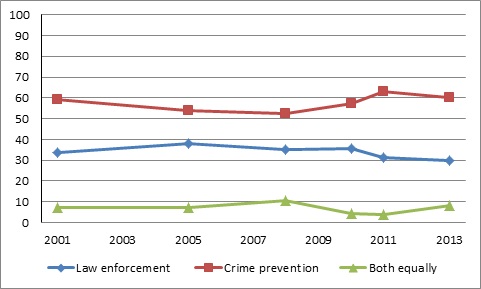
Crime Prevention vs. Law Enforcement
Since 2006 the Canadian government has focused on being tough on crime. The policy approach continues to this day but it seems the Canadian public is starting to see these changes as a policy excess. Instead of focusing on punishment, public opinion polls suggest the government focus should be on prevention through education and social development programs.
What do you think? How would you like to see crime addressed in Canada? Do you think we need changes to crime legislation? Would you like to see additional investments in social development programs?
Norrander, B. (2000). The multi-layered impact of public opinion on capital punishment implementation in the United States. Political Research Quarterly, 53(4).
Posted on: January 8th, 2014 by Waterloo Region Crime Prevention Council
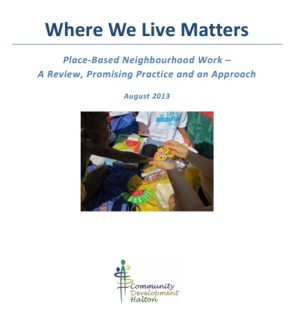 Title: Where We Live Matters | Place-based neighbourhood work – A review, promising practice and an approach
Title: Where We Live Matters | Place-based neighbourhood work – A review, promising practice and an approach
Authors: Jody Orr and staff of Community Development Halton
This new publication from Community Development Halton is a comprehensive read for any community development animator who works directly in neighbourhoods. Recognizing that the landscape of community work has changed dramatically in the past two decades, Orr and her associates urge us to adapt our approaches with the changing needs of our communities. And in case you’ve missed it, communities have changed!
This 70 page publication makes the case for ‘place-based neighbourhood work’ and details an engagement framework (pictured below) – An Approach to Building Neighbourhoods. Community work never follows a linear process and “Where We Live Matters” recognizes that neighbourhoods operate in a cyclical, repeated fashion between all stages of the engagement process depending on the issue or situation and the people involved in the work. It’s messy, chaotic and creative work and it’s hard to capture it accurately on paper!
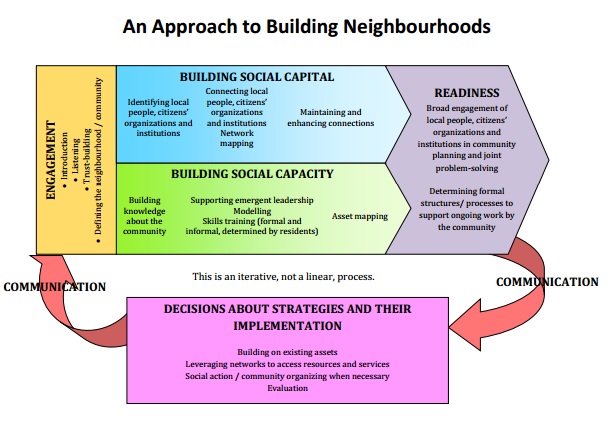
What I like about the model (pictured above) is that they break down the engagement process into more manageable building blocks. I can’t recall ever seeing ‘readiness’ so prominently placed in an engagement process – we all know it’s necessary – so glad to see it named in plain language. I think the distinction between social capital and social capacity is important. Too often, they are used interchangeably, but they truly are distinct concepts in community building.
The remainder of the article outlines:
- the key characteristics of communities in which effective community building processes have been carried out,
- the personal and professional qualities and skills of the people involved in effective neighbourhood work
- best and promising practices in neighbourhood work, focusing on place-based activity
- a brief history of place-based neighbourhood work
When you read the brief history of place-based work (Appendix 1), it’s easy to see how far community work has strayed from the direct neighbourhood level. “Where We Live Matters” urges a shift from the universal, service delivery approaches of the past decades, revisiting the classic community development approach of place-based work. There’s no denying it; there are unique and pressing needs in specific geographic areas of every city, town and municipality. Try as we might, universal approaches will never reach the most vulnerable neighbourhoods in our communities. The work needs to be done where it matters most – in neighbourhoods where people live, and with people who live there.
There’s a subtext to this article that is hard to ignore. It speaks to the role of traditional service delivery institutions, large systems and government social policy. Essentially… these entities are too slow and inflexible enough to respond to the needs of neighbourhoods. Often, these systems and institutions are so policy bound that they actually become an obstacle for the communities they are designed to be helping. Which reminds me of so many stories from the very wise Jim Diers who claims that government and large agencies are often the greatest stumbling block for neighbourhoods and communities.
Isn’t that upside down?
As a community practitioner and animator myself, it’s always refreshing to come across good applied research and this one is solidly rooted in practice and the experience of people working effectively with neighourhoods. The authors draw on the work of pioneers of community work such as:
- Joh McKnight
- John Kretzman
- Bill Lee
- Margaret Wheatley
- Paul Mattessich, Barbara Monsey & Corinna Roy
“Where we live matters” is not new earth-shaking work, but resonates with my own community work as an animator and echoes the growing plethora of place-based initiatives such as:
To better understand the document, check out this Tamarack podcast with Joey Edwardh, Jody Orr and Rishia Burke of Community Development Halton. They lead you through this resource document including an exploration of what inspired the investigation, the important role of an “animator” who enlivens and encourages development in community, funding for work that is hard to measure, and more!
After reading “Where we live matters” I wanted to go pull the McKnight, Kretzman, Lee and Wheatley books from the bookshelf and get reacquainted with the foundations of place-based work. There’s inspiration to be found for our daily work.
But most importantly, “Where we live matters” reminds us that what goes on in our neighbourhoods and the quality of life there has the greatest impact on our quality of daily living. We absolutely should be investing in neighbourhoods.
Posted on: January 6th, 2014 by Waterloo Region Crime Prevention Council
“I feel responsible…..” These are the exact words from a parent following a neighbourhood discussion about youth, drugs and addiction. But it’s maybe not the story you are imagining.
In my work as Community Engagement Coordinator with the Waterloo Region Crime Prevention Council, I spend some of my time with neighbourhoods, working through issues and challenges that have emerged over time or might be the result of a community crisis.
After facilitating a few meetings during the summer and early fall with a group of neighbourhood parents, they decided they wanted to learn about issues of substance use, addictions and youth. As parents they were very clear that they wouldn’t want their own children to use drugs, but they needed a better understanding of why some youth would take or use drugs, including youth in their own neighbourhood.
One evening, we watched the film Reduce Speed – a documentary about 5 teens who share their experience with using crystal meth. The film is told with their voices, their stories, their reality – which is helpful for adults to hear!
The film is heavy and is difficult for any parent to watch. “Sad”, “concerned”, “worried”, “depressed”, “at a loss”, “sick”, “sorry”, “serious”,…. were words these parents used to describe how they felt after seeing this 22 minute film.
A 2 hour discussion followed and we covered a lot of territory:
- how parents talk to youth about drugs and alcohol in a way that doesn’t become confrontational
- the challenges and pressures youth face about drugs and alcohol on a daily basis
- what might prompt youth to use drugs
- what youth see in their own neighbourhood with respect to drugs and alcohol use
- what might be some root issues or causes for youth who use drugs and alcohol
- what can the community do and who can help
The group plans to gather again to deepen their learning and understanding and move toward some action.
Before leaving the group, I asked each person to use one word to describe how they felt at the end of the evening. “Encouraged”, “hopeful”, “inspired”, “happy”, “energized”, “grateful”…. very different feelings than at the beginning of the discussion!
But something profound happened when one woman interrupted our leave-taking to add one more thought; raising her voice to be heard above the scrapping of chairs and rustling of coats, she said clearly, “I feel responsible”. She went on to explain that, before, the problem felt too big, too insurmountable, but she gained a different perspective through the film and our discussion and wants to be part of creating a change in her neighbourhood through her own actions, together with her neighbourhood.
This was a stunning moment, one that brought a lump to my throat. To see the roots of change emerge before my very eyes is a rare thing. This woman knows that everyone has a role to play in prevention, no matter how small or big, and that through individual and collaborative leadership, we can make change happen.
I can’t wait to see the leadership, action and responsibility that this group will take in 2014.
What kind of change will you be part of in your neighbourhood this year?
Posted on: December 31st, 2013 by Waterloo Region Crime Prevention Council
I just love this time of January when you get to take a look back at what’s been accomplished over the past year, ponder what worked well and scratch your head about what emerged that you never expected.
As we turn the page into 2014, I also love the tradition of digging into our blog to find what you, the readers, found most interesting over the last year. With over 45 blog posts in 2013, there was certainly something for everyone. We had 23 different guest bloggers contribute community responses on the root causes of crime as part of the Snapshot in Time: Root Causes of Crime in Waterloo Region. You can find all the posts and community responses in one tidy corner of the blog.
But, our readers are diverse which indicates why our most popular blogs on Smart on Crime ranged from book reviews to casinos and from guest commentary to provincial budget analysis. Here’s the round up of our top 13 posts from 2013.
1. The local impact of youth unemployment/underemployment – guest post by Carol Simpson
“If youth in the labour market cannot find employment, they find it increasingly difficult to become established in the “adult” world. They have done nothing wrong. They have done what they were told to do and were supposed to do yet cannot find that suitable connection to the workforce. This impacts their confidence and their ability to “fit in”. Many have chosen to give up and have simply walked away from the labour market making it even harder to find their “place” in the world. This results in frustration and anger and they feel neglected.”
2. What we’re reading: Rescuing Policy – by Anthony Piscitelli
“How can government solve the complex issues facing society?”
3. Children in care in Waterloo Region: Compounding risk for vulnerable children – by Jill Stoddart
“Children living in the care of the child welfare system have a higher likelihood of justice system involvement in comparison to children living with their biological parents”.
4. Excuse me Waterloo Region, your homelessness is showing – by Lynn Macaulay
“I feel part of a sector where I join in solidarity with people experiencing homelessness and many community members who together stand up to say – people who are homeless matter. We collectively are committed to ending homelessness in Waterloo Region. This is a lofty goal, which will take much persistence and hard work, but with the determination and skills of this community, I believe it is possible.”
5. Income of low income families: Root cause of crime in Waterloo Region – by Anthony Piscitelli
Neighbourhoods that are at an economic disadvantage when compared to other areas report higher crime rates. In addition, societies where wealth is concentrated amongst a small group of individuals report higher crime rates.
6. Through the eyes of crime prevention: Ontario 2013 Budget – prepared by Alexadra Kraushaar

7. The day I went to prison – by Andrew Jackson
“Five minutes later I stood at the front of a classroom with 25 women waiting for me to start talking. “Good morning” I said. “Good morning.” came the reply from the women of Grand Valley Institution for Women (GVI).”
8. Knowing other people care: The importance of community to women who have experienced homelessness – by Elizabeth Clarke
“It goes almost without saying that the overarching cause of homelessness is poverty, but not all people who are poor become homeless. Not all people who become homeless stay that way for long.”
9. Waterloo Region’s Catholic Schools: Laying a solid foundation for student success – by David DeSantis
“It is no surprise that the length of involvement in schooling significantly impacts participation in criminal activity and the probability of incarceration, as found in Snapshot in Time: Root Causes of Crime in Waterloo Region. In fact, this has been well-known in the education sector for many years – which explains the great lengths to which school boards go in mitigating against this problem.”
10. 7 things we learned from Alan Quarry about social media for social change – by Juanita Metzger
“Creating change that lasts happens in relationships, from one person to another, and these days, often facilitated with the power of social media. Here are Alan’s 7 best thoughts on the principles for engaging people in change.”
11. A Snapshot in Time: The Root Causes of Crime in Waterloo Region – by Anthony Piscitelli
“The Waterloo Region Crime Prevention Council believes monitoring the root causes of crime can aid the community in addressing crime, victimization and fear of crime through awareness, discussion, leadership and action. Once the root causes are understood more clearly, resources can be applied to areas where the community is doing poorly. A Snapshot in Time: The Root Causes of Crime in Waterloo Region identifies the root causes of crime right here in Waterloo Region and provides a tool to aid local policy makers in targeting interventions to where they are most needed and where they can have the greatest impact.”
12. Poverty in Waterloo Region… Is that REALLY OK with you? – by Mary MacKeigan
“The data in the section of Root Causes of Crime in Waterloo Region titled Income of Low Income Families is no surprise to those of us who are familiar with poverty-related issues in our regional community. In fact, in Waterloo Region, 36 earners make more than $2.57M; 360 make more than $685K; 3,610 (the top 1%) make more than $396K. Individuals who make more than $81,200 are in the top 10%. On the other hand, the median income of the bottom 50% is $14,100!* In 2007, one third of employed individuals were earning $14.00/hour or less. This is poor – it may not be deep (or absolute) poverty, but it is precariously close to it. “
13. What are the odds? The vulnerable child of today as the problem gambler of tomorrow – by Chris Sadeler
“The official position statement of the Waterloo Region Crime Prevention Council given at a public consultation on the question of a casino in the City of Kitchener. The remarks were given by WRCPC Executive Director, Christiane Sadeler on behalf of the Waterloo Region Crime Prevention Council.”
So many great reads from 2013. But if you’re in the mood for something to watch, rather than read, might I suggest our personal favourite, “Won’t you be my neighbour?” Who can resist Anthony Piscitelli’s homage to Mr. Rogers!
We look forward to bringing more great smart on crime blogs for you to ponder. Better yet, we love hearing your comments, reactions and responses to the posts and guest commentaries. We look forward to hearing more from you in 2014!
Posted on: December 17th, 2013 by Waterloo Region Crime Prevention Council
The crime rate records the amount of police reported crime per 100,000 people. In this number, all crimes are counted equally. This represents approximately one third of the crime that occurs in Canada; this varies by jurisdiction and type of crime. The Crime Severity Index and the Violent Crime Severity Index weight crimes according to their severity based upon average sentencing outcomes. Crime and violence severity indices address the crime rate being driven by high-volume offences that are of a less serious nature.
The Statistics
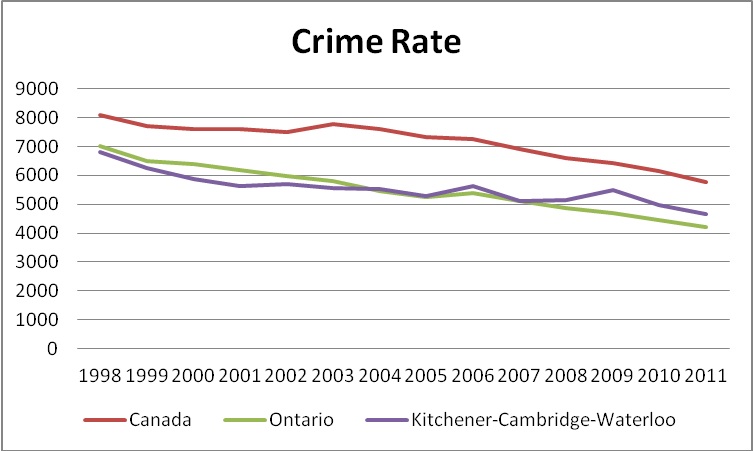
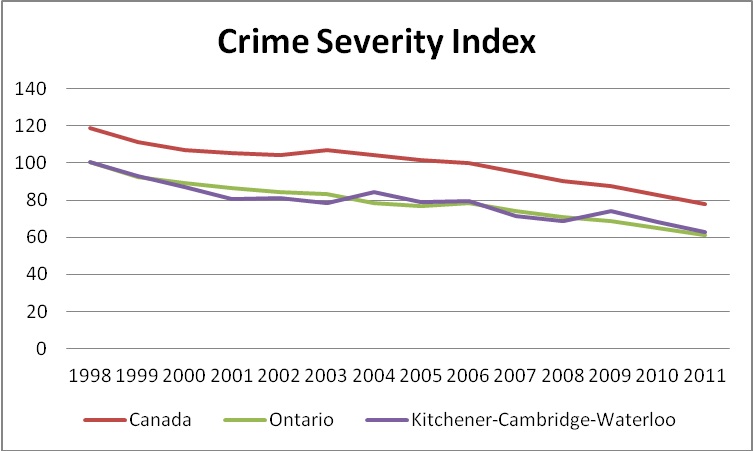
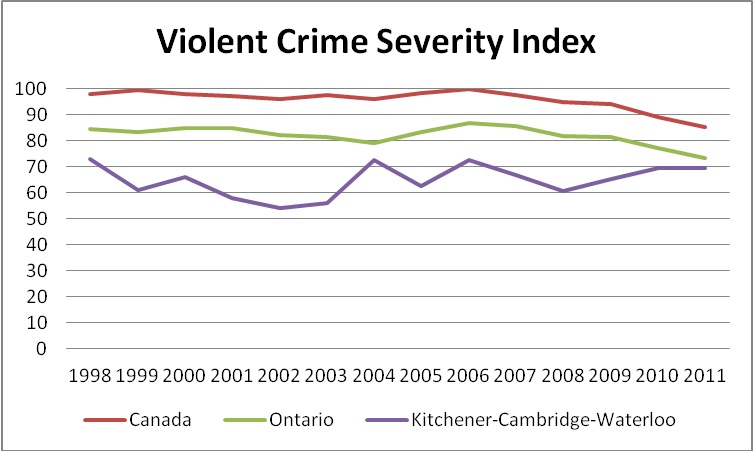 Date Sources: Statistics Canada, Uniform Crime Reporting Survey: CANSIM Table 2520051
Date Sources: Statistics Canada, Uniform Crime Reporting Survey: CANSIM Table 2520051
Statistics Canada, Uniform Crime Reporting Survey: CANSIM Table 2520052 (Released Annually)
The Story Behind the Numbers
Posted on: December 4th, 2013 by Waterloo Region Crime Prevention Council
Communities with a higher proportion of lone-parent headed households are associated with higher crime rates. Children from lone parent headed households face low incomes and other significant risk factors for becoming a victim or perpetrator of crime. The chart below tracks percentage of lone parent families in Waterloo Region and Ontario. The second chart tracks two parent family median incomes and single family median incomes. The gap between the two assesses whether single-parent headed households are falling behind when compared to two parent households.
The Statistics
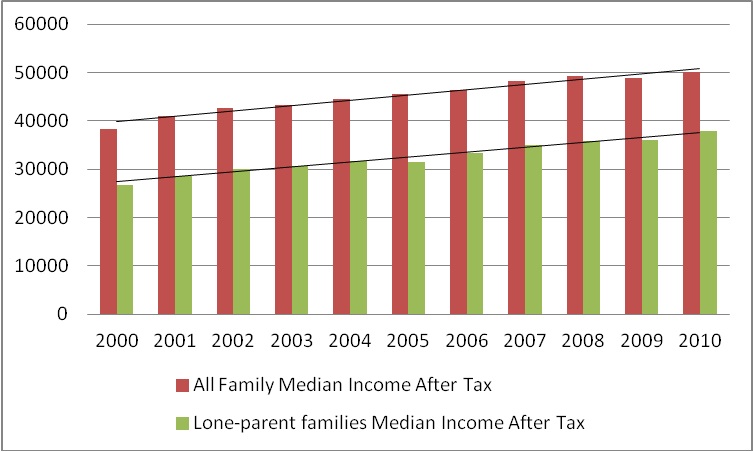
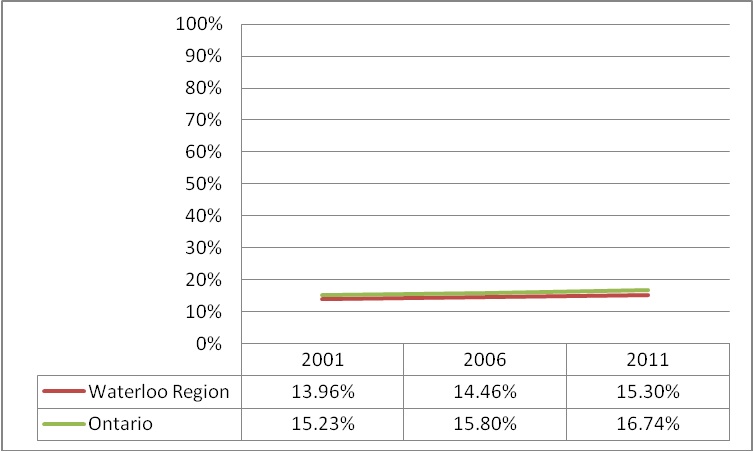 Data Sources: Statistics Canada, Census (Released Every Five Years); Statistics Canada, CANSIM Table 111-0015 (Released Annually)
Data Sources: Statistics Canada, Census (Released Every Five Years); Statistics Canada, CANSIM Table 111-0015 (Released Annually)
The Story Behind the Numbers
Waterloo Region has less single parent headed households than Ontario. However, single parent families have increased in Ontario and Waterloo Region over the past ten years. Interestingly in Waterloo Region the income of single parent headed households is growing slightly faster than two parent families in the Kitchener-Cambridge-Waterloo CMA. So while single parent headed households are growing in the region their income is keeping pace with average incomes, unfortunately they are not making any significant gains to close the gap.
Read the Community Response:
Single Parent Headed Households: A response from Big Brothers Big Sisters of Waterloo Region with Julie Philips
Posted on: November 19th, 2013 by Waterloo Region Crime Prevention Council
Fear of crime may cause an increase in crime within a community. Although there is not a consensus in the literature around this point, it is clear that fear of crime is unwelcome and tends to negatively impact quality of life. Fear of crime is measured in this survey as the percentage of respondents indicating they feel very unsafe, or somewhat unsafe, walking alone in their area after dark.
The Statistics
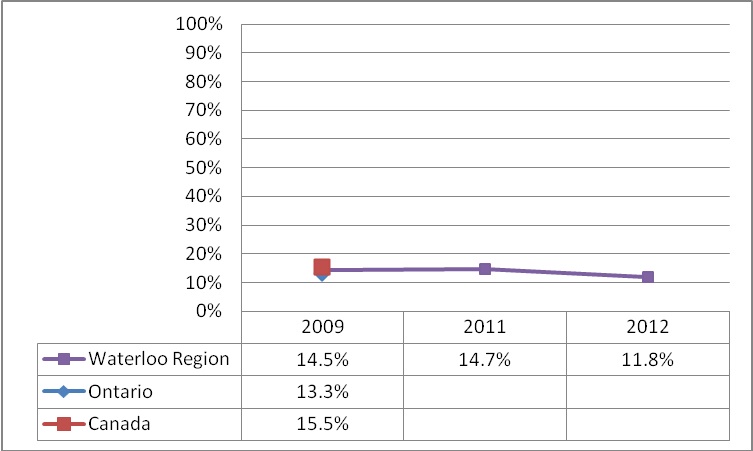 Data Sources: Statistics Canada General Social Survey Victimization Cycle (Released Every Five Years) University of Waterloo Survey Research Centre Local Area Survey (Released Annually)
Data Sources: Statistics Canada General Social Survey Victimization Cycle (Released Every Five Years) University of Waterloo Survey Research Centre Local Area Survey (Released Annually)
The Story Behind the Numbers
Levels of fear of crime in a community are expected to be relatively stable in the short term. Locally, levels of fear of crime are stable with changes within the margin of error. Comparing Waterloo Region to Ontario and Canada, the numbers are relatively similar with Waterloo Region appearing to have a slightly lower fear of crime than Canada.
Read the Community Responses:
Posted on: November 12th, 2013 by Waterloo Region Crime Prevention Council
Social capital refers to the human connections and capacities that contribute to the wealth and well being of a community. Social capital is developed in many ways such as participating in community groups, helping someone solve a problem or by saying hello to a neighbour. High levels of social capital have been linked to reduced violence in neighbourhoods. A community characterized by strong interpersonal connections helps to reduce crime by making it more likely that people in the community will watch over the neighbourhood. A simple and widely accepted measure of social capital asks the question, ‘Generally speaking, would you say that most people can be trusted or that you cannot be too careful in dealing with people?’
The Statistics
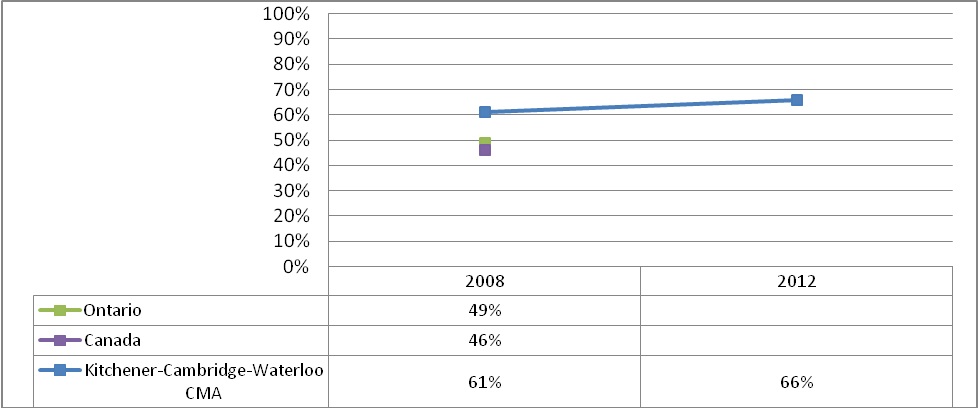
Data Sources: Statistics Canada, General Social Survey Time Use Cycle (Released Every Five Years); University of Waterloo Survey Research Centre, Local Area Survey (Released Annually)
The Story Behind the Numbers
Social trust is slightly higher in Ontario than it is in Canada and it is significantly higher in the Kitchener-Cambridge-Waterloo Census Metropolitan Area (CMA). Similar results were found on a second question in the 2008 General Social Survey, asking how much respondents trust people in their neighbourhood. The results bode well for Waterloo Region and present an important protective factor for the community. The increase in social capital between 2008 and 2012 is within the margin of error, indicating that social capital in the region is stable. Social capital does not form by itself. It tends to be the outcome of strategic and focused efforts on behalf of local institutions including the grass roots and local government to ensure an informed and engaged citizenry.
Read the Community Responses:
Life at 17 by Karen Scian, Waterloo City Councillor, Conestoga College instructor, Waterloo Public Library Trustee, Chair of the Board for Community Justice Initiatives




 Title:
Title: 



 Date Sources: Statistics Canada, Uniform Crime Reporting Survey: CANSIM Table 2520051
Date Sources: Statistics Canada, Uniform Crime Reporting Survey: CANSIM Table 2520051
 Data Sources: Statistics Canada, Census (Released Every Five Years); Statistics Canada, CANSIM Table 111-0015 (Released Annually)
Data Sources: Statistics Canada, Census (Released Every Five Years); Statistics Canada, CANSIM Table 111-0015 (Released Annually) Data Sources: Statistics Canada General Social Survey Victimization Cycle (Released Every Five Years) University of Waterloo Survey Research Centre Local Area Survey (Released Annually)
Data Sources: Statistics Canada General Social Survey Victimization Cycle (Released Every Five Years) University of Waterloo Survey Research Centre Local Area Survey (Released Annually)